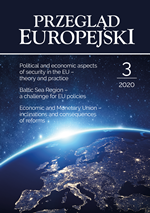Eurozone ten years after the crisis. Structural weaknesses, implemented reforms and the future of the reform process
Eurozone ten years after the crisis. Structural weaknesses, implemented reforms and the future of the reform process
Author(s): Marcin WrońskiSubject(s): Politics / Political Sciences, Political Sciences
Published by: Wydawnictwa Uniwersytetu Warszawskiego
Keywords: Eurozone (euro area); Economic and Monetary Union (EMU); EMU reform; European Union; Eurozone crisis; financial crisis; strefa euro; Unia Gospodarcza i Walutowa (UGW); reforma UGW; Unia Europejska
Summary/Abstract: The article discusses the structural weaknesses of the Economic and Monetary Union (EMU), keyreforms introduced after the financial crisis and the most important proposals of further EMU reformspresent in the public debate. Reforms introduced during the last decade should be deemed to havepositive results, however the EMU reform process has not yet been finished. Its successful completiondepends on an agreement between Germany and France, which is hindered by conflicting economicinterests and by different views on economic policy. The main purpose of this article is to demonstratehow public policy makers attempt to respond to the structural weakness of the Economic and Monetary Union and to identify the key factors, which impede an agreement between France and Germany
Journal: Przegląd Europejski
- Issue Year: 2020
- Issue No: 3
- Page Range: 79-95
- Page Count: 17
- Language: English

